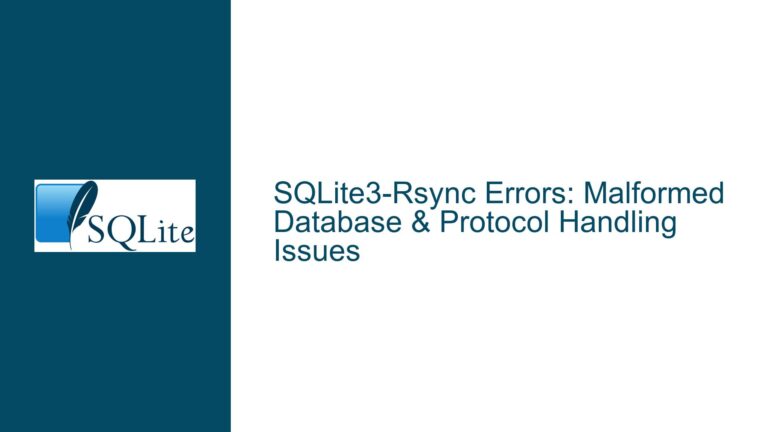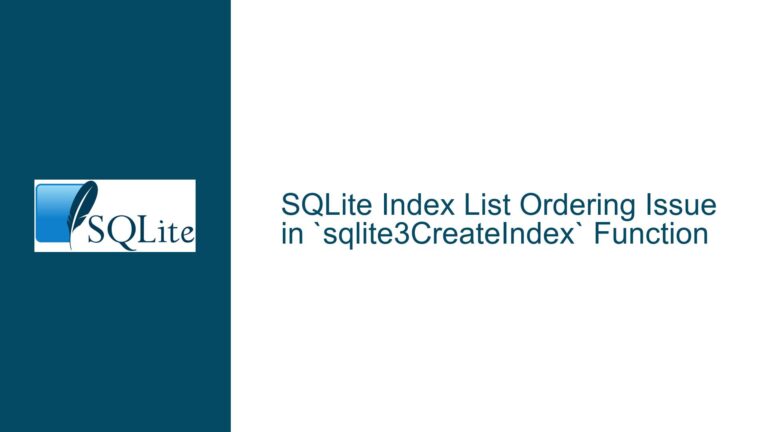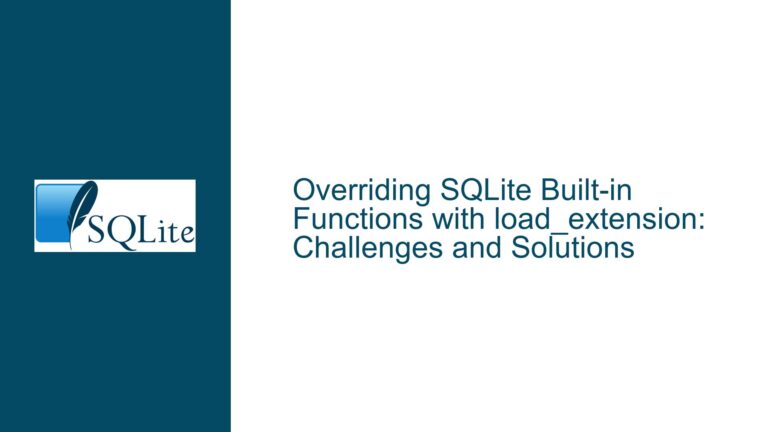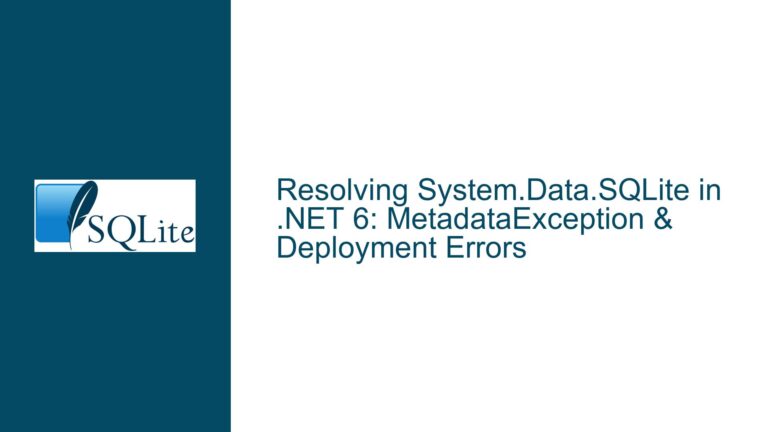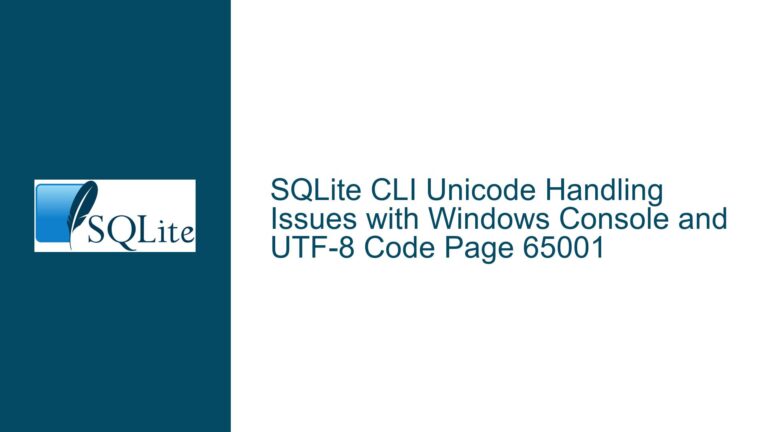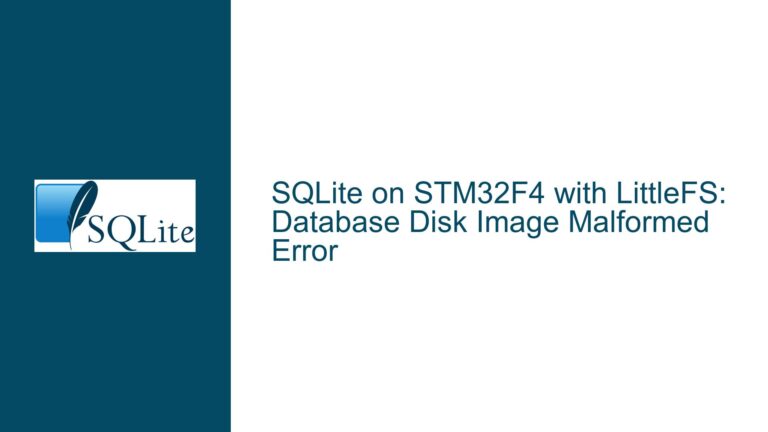Programming SQLite Bytecode Directly: Risks, Limitations, and Alternatives
SQLite Bytecode Programming: Understanding the Risks and Limitations
SQLite bytecode, as documented in the official SQLite opcode documentation, is a low-level representation of SQL statements that the SQLite virtual machine executes. While it may seem tempting to program SQLite bytecode directly for custom applications, such as creating a datalog-like front end, this approach is fraught with significant risks and limitations. The primary issue stems from the fact that SQLite bytecode is not designed for direct human programming. Instead, it is an internal representation generated by SQLite’s code generator during the compilation of SQL statements.
One of the most critical limitations is the lack of stability in the bytecode opcodes across different versions of SQLite. The SQLite development team frequently updates and modifies the opcodes to improve performance, add new features, or fix bugs. As a result, bytecode written for one version of SQLite may not be compatible with future versions. This version dependency makes direct bytecode programming impractical for long-term projects or applications that require regular updates to the SQLite library.
Another significant risk is the potential for undefined behavior, including segmentation faults and memory corruption. SQLite bytecode is optimized for execution by the SQLite virtual machine, and it assumes that the bytecode has been generated by SQLite’s internal code generator. Directly programming bytecode bypasses the safeguards and error-checking mechanisms built into the code generator, leading to unpredictable and potentially catastrophic outcomes. For example, improperly constructed bytecode could result in invalid memory accesses, data corruption, or even crashes in the SQLite library.
Furthermore, SQLite bytecode is not designed to handle corner cases gracefully. The code generator ensures that the bytecode it produces is robust and handles all possible edge cases, such as null values, type mismatches, and constraint violations. When programming bytecode directly, developers must manually account for these edge cases, which is both error-prone and time-consuming. Even a small mistake in the bytecode can lead to subtle bugs that are difficult to diagnose and fix.
In summary, while the idea of programming SQLite bytecode directly may seem appealing for certain specialized applications, the risks and limitations far outweigh the potential benefits. The lack of version stability, the potential for undefined behavior, and the difficulty of handling edge cases make this approach unsuitable for most practical use cases. Instead, developers should consider alternative approaches that leverage SQLite’s strengths while avoiding the pitfalls of direct bytecode programming.
Interrupted Write Operations Leading to Index Corruption
One of the most common issues that can arise when working with SQLite is database corruption, particularly after unexpected interruptions such as power failures or system crashes. This corruption often manifests as index corruption, where the indexes used to speed up queries become inconsistent with the actual data stored in the database. Understanding the causes of index corruption is essential for preventing and mitigating this issue.
Index corruption typically occurs when a write operation is interrupted before it can be completed. SQLite uses a transactional model to ensure data consistency, where changes to the database are written to a journal file before being applied to the main database file. This journaling mechanism allows SQLite to roll back incomplete transactions and recover from interruptions. However, if an interruption occurs at the wrong moment, such as during the writing of an index entry, the journal may not be able to fully recover the database state, leading to index corruption.
Another potential cause of index corruption is the use of improper journaling modes. SQLite supports several journaling modes, including DELETE, TRUNCATE, PERSIST, and WAL (Write-Ahead Logging). Each mode has different trade-offs in terms of performance and durability. For example, the DELETE mode is the most durable but also the slowest, as it requires deleting the journal file after each transaction. On the other hand, the WAL mode offers better performance and concurrency but may be less durable in certain scenarios. Using an inappropriate journaling mode for a given workload can increase the risk of index corruption.
Additionally, hardware issues such as faulty storage devices or memory corruption can also lead to index corruption. SQLite relies on the underlying storage system to reliably read and write data, and any errors in the storage system can result in corrupted database files. Similarly, memory corruption caused by bugs in the application or operating system can lead to incorrect data being written to the database, further increasing the risk of index corruption.
In summary, index corruption in SQLite is often the result of interrupted write operations, improper journaling modes, or hardware issues. Understanding these causes is the first step in preventing and mitigating index corruption. By using appropriate journaling modes, ensuring reliable hardware, and implementing proper error handling, developers can reduce the risk of index corruption and maintain the integrity of their SQLite databases.
Implementing PRAGMA journal_mode and Database Backup Strategies
To prevent index corruption and ensure the integrity of SQLite databases, it is essential to implement proper journaling modes and database backup strategies. SQLite provides several PRAGMA statements that allow developers to configure the journaling mode and other settings that affect database durability and performance. Additionally, regular database backups can help recover from corruption and minimize data loss.
One of the most effective ways to prevent index corruption is to use the WAL (Write-Ahead Logging) journaling mode. The WAL mode offers several advantages over traditional journaling modes, including better performance, improved concurrency, and reduced risk of corruption. In WAL mode, changes are written to a separate WAL file before being applied to the main database file. This allows multiple readers and writers to access the database simultaneously without blocking each other. Furthermore, the WAL file is append-only, which reduces the risk of corruption during interruptions.
To enable WAL mode, developers can use the following PRAGMA statement:
PRAGMA journal_mode=WAL;
Once WAL mode is enabled, SQLite will automatically manage the WAL file and ensure that changes are safely written to the main database file. However, it is important to note that WAL mode may not be suitable for all scenarios, particularly in environments with limited storage or where durability is a top priority. In such cases, developers may need to use a different journaling mode or implement additional safeguards.
Another important consideration is the use of database backups. Regular backups can help recover from corruption and minimize data loss in the event of a failure. SQLite provides several methods for creating backups, including the .backup command in the SQLite command-line interface and the sqlite3_backup_init API in the SQLite C interface. These methods allow developers to create a complete copy of the database, including all tables, indexes, and other objects.
For example, the following command creates a backup of a SQLite database using the command-line interface:
sqlite3 original.db ".backup backup.db"
In addition to full backups, developers can also implement incremental backups by copying only the changes since the last backup. This can be done using the WAL file in WAL mode, as the WAL file contains all the changes that have not yet been applied to the main database file. By regularly copying the WAL file to a backup location, developers can ensure that they have a complete and up-to-date copy of the database.
Finally, it is important to test backups regularly to ensure that they can be successfully restored. A backup is only useful if it can be restored in the event of a failure, and testing backups helps identify any issues before they become critical. Developers should also consider implementing automated backup scripts and monitoring tools to ensure that backups are performed regularly and without errors.
In summary, implementing proper journaling modes and database backup strategies is essential for preventing index corruption and ensuring the integrity of SQLite databases. By using the WAL journaling mode, creating regular backups, and testing backups regularly, developers can reduce the risk of corruption and minimize data loss in the event of a failure. These practices are critical for maintaining the reliability and durability of SQLite databases in production environments.

